Identification and Characterization of Volatile Organic Compounds Based on GC-IMS Technology in Different Organs of Lilium brownii var. viridulum and After Bud-Removal and Non-Bud-Removal Treatments
Abstract
1. Introduction
2. Results and Discussion
2.1. GC-IMS Spectroscopic Analysis of Longya Lily
2.2. Identification of Volatile Organic Compounds in Longya Lily
2.3. Fingerprint Mapping Study
2.3.1. Fingerprinting Study of VOCs in Different Organs of Longya Lilies
2.3.2. Fingerprinting of VOCs in Longya Lilies Undergoing Bud-Removal and Non-Bud-Removal Treatments
2.4. Multivariate Statistical Analysis
2.4.1. Principal Component Analysis and Correlation Study of VOCs in Different Organs of Longya Lily
2.4.2. Principal Component Analysis and Correlation Study of VOCs in Longya Lilies After Bud-Removal and Non-Bud-Removal Treatments
2.4.3. Volatile Organic Compounds
3. Materials and Methods
3.1. Sample Preparation and Collection
3.2. Chemicals and Instruments
3.3. GC-IMS Analysis
3.4. Statistical Analysis
4. Conclusions
Supplementary Materials
Author Contributions
Funding
Institutional Review Board Statement
Informed Consent Statement
Data Availability Statement
Conflicts of Interest
Abbreviations
| GC-IMS | Gas chromatography–ion mobility spectrometry |
| VOCs | Volatile organic compounds |
| E-nose | Electronic nose |
| GC-O | Gas chromatography–olfactometry |
| OPLS-DA | Partial least squares discriminant analysis |
| VIP | Variable importance |
References
- He, D.; Zhang, H.C.; Li, S.H.; Zhou, X.; Zhang, S.H. Research Progress on Chemical Constituents and Pharmacological Effects of Baihe (Lilii Bulbus) and Predictive Analysis on Quality Markers. Chin. Arch. Tradit. Chin. Med. 2022, 40, 205–212. [Google Scholar]
- Hu, Z.D.; Tian, S.; Miao, Y.Y.; Miao, M.S. Chemical Composition, Pharmacological Research, and Clinical Application of Baihe. Pharmacol. Clin. Chin. Mater. Med. 2022, 38, 241–246. [Google Scholar]
- Zhang, T.; Gao, J.; Jin, Z.Y.; Xu, X.M.; Chen, H.Q. Protective effects of polysaccharides from Lilium lancifolium on streptozotocin-induced diabetic mice. Int. J. Biol. Macromol. 2014, 65, 436–440. [Google Scholar] [CrossRef]
- Sim, W.S.; Choi, S.I.; Jung, T.D.; Cho, B.Y.; Choi, S.H.; Park, S.M.; Lee, O.H. Antioxidant and anti-inflammatory effects of Lilium lancifolium bulbs extract. J. Food Biochem. 2020, 44, e13176. [Google Scholar] [CrossRef] [PubMed]
- Wang, Y.F.; An, Z.Y.; Yuan, L.Q.; Wang, T.; Jin, W.L. Lilium brownii/Baihe as Nutraceuticals: Insights into Its Composition and Therapeutic Properties. Pharmaceuticals 2024, 17, 1242. [Google Scholar] [CrossRef]
- Fu, C.Y.; Liu, Y.H.; Zeng, L.; Li, J.H.; Yang, Z.H.; Chen, B. GC-MS Analysis of the Composition of the Volatile Oil from Lilii Bulbus by Supercritical-CO2 Fluid Extraction. Chin. J. Mod. Appl. Pharm. 2015, 32, 715–718. [Google Scholar]
- Li, H.J.; Niu, L.X.; Li, Z.L.; Zhang, Y.L. GC-MS analysis of the composition of the volatile oil from the bulbs of L. lancifolium Thunb. with different cultivated modes. J. Northwest A F Univ. Nat. Sci. Ed. 2007, 89, 149–152. [Google Scholar]
- Liu, Y.J.; Tang, Y.C.; Luo, K.; Sun, M.; Xu, L.F.; Yang, P.P.; Ming, J. Application status of lily in cosmetics. Appl. Chem. Ind. 2024, 53, 2385–2390. [Google Scholar]
- Li, H.; Chang, J.; Zhao, J.; Liu, C.Y.; Wang, Z.J.; Tian, F.L. Study on Volatile Oils of Lilium longiflorum by Different Extraction Methods with GC-MS. North. Hortic. 2012, 48, 90–94. [Google Scholar]
- Wu, J.H.; Zhang, G.F.; Zhao, R.D.; Wang, N.; Su, T.Y.; Chen, X.B. Evaluation of the Chemical Constituents of the Essential Oil from Four Kinds of Lilies with by GC-MS. Chin. J. Ethnomedicine Ethnopharmacy 2022, 31, 42–49. [Google Scholar]
- Jiang, X.; Bi, W. Study on chemical composition of lilim essential oil from Lanzhou. China Sci. Technol. Inf. 2013, 36, 66–68. [Google Scholar]
- Li, P.P.; Han, J.G.; Chen, X.; Gao, L.H. Research and practice on the main models and supporting technologies of ecological greenhouse agriculture in China. J. Zhejiang Univ. Sci. B 2024, 50, 149–160. [Google Scholar]
- Jie, L.; Ya, J.W.; Yang, Q.; Zhong, K.X.; Yu, B.Z.; Cui, P.H. Decomposition effects of Lanzhou lily (Lilium davidii var. unicolor) flowers on soil physical and chemical properties and microbial community diversity. Sci. Cold Arid Reg. 2022, 14, 212–222. [Google Scholar]
- Luo, A.H.; Huang, J.; Liu, F. Effects of different flower-picking treatments on bulb growth of Lily Lily. Contemp. Hortic. 2023, 46, 1–2. [Google Scholar]
- Zhen, P.H.; Shen, W.X.; Yu, B. Introduction and cultivation techniques of Longya lily in northern Zhejiang. Shanghai Agric. Sci. Technol. 2020, 54, 82–83. [Google Scholar]
- Chen, L.D.; Jiang, S.Y.; Ren, G.Y.; Zhang, Z.R. Effect of Different Bud Picking Time on Lily Bulb Yield. Mod. Agric. Sci. Technol. 2009, 53, 73–75. [Google Scholar]
- Yang, J.H.; Cui, S.; Sun, M.J.; Liu, K.; Tao, H.; Zhang, D.; Yan, Z.H.; Kang, C.Y.; Zhao, C.Q. Dynamic evolution of volatile compounds during cold storage of sturgeon fillets analyzed by gas chromatography-ion mobility spectrometry and chemometric methods. Food Chem. 2024, 464, 141741. [Google Scholar] [CrossRef]
- Li, H.; Xi, B.; Lin, S.; Tang, D.; Gao, Y.; Zhao, X.; Liang, J.; Yang, W.; Li, J. Volatile Flavor Analysis in Yak Meat: Effects of Different Breeds, Feeding Methods, and Parts Using GC-IMS and Multivariate Analyses. Foods 2024, 13, 3130. [Google Scholar] [CrossRef]
- Liu, G.; Duan, H.; Zheng, Y.; Guo, J.; Wang, D.; Yan, W. Differences in the Determination of Volatile Organic Compounds between Chrysanthemum morifolium Ramat. and Chrysanthemum indicum L. (Wild Chrysanthemum) by HS-GC-IMS. Molecules 2024, 29, 4609. [Google Scholar] [CrossRef]
- Li, S.; He, X.; Zhang, X.; Kong, K.W.; Xie, J.; Sun, J.; Wang, Z. Integration of volatile and non-volatile metabolite profile, and in vitro digestion reveals the differences between different preparation methods on physico-chemical and biological properties of Gastrodia elata. Food Chem. 2025, 463, 141177. [Google Scholar] [CrossRef]
- Sun, B.; Yan, Y.; Ma, M.; Wen, J.; He, Y.; Sun, Y.; Yuan, P.; Xu, P.; Yang, Y.; Zhao, Z.; et al. Based on HPLC and HS-GC-IMS Techniques, the Changes in the Internal Chemical Components of Schisandra chinensis (Turcz.) Baill. Fruit at Different Harvesting Periods Were Analyzed. Molecules 2024, 29, 1893. [Google Scholar] [CrossRef]
- Li, C.; Wan, H.; Wu, X.; Yin, J.; Zhu, L.; Chen, H.; Song, X.; Han, L.; Yang, W.; Yu, H.; et al. Discrimination and Characterization of the Volatile Organic Compounds in Schizonepetae Spica from Six Regions of China Using HS-GC-IMS and HS-SPME-GC-MS. Molecules 2022, 27, 4393. [Google Scholar] [CrossRef]
- Jin, W.; Cai, W.; Zhao, S.; Gao, R.; Jiang, P. Uncovering the differences in flavor volatiles of different colored foxtail millets based on gas chromatography-ion migration spectrometry and chemometrics. Curr. Res. Food Sci. 2023, 7, 100585. [Google Scholar] [CrossRef] [PubMed]
- Azizan, K.A.; Baharum, S.N.; Ressom, H.W.; Noor, N.M. GC-MS Analysis and PLS-DA Validation of the Trimethyl Silyl-Derivatization Techniques. Am. J. Appl. Sci. 2012, 9, 1124–1136. [Google Scholar]
- Fu, C.; Zou, Y.; Zhang, Y.; Liao, M.; Chen, D.; Guo, Z. Comparison of Different Deodorizing Treatments on the Flavor of Paddy Field Carp, Analyzed by the E-Nose, E-Tongue and Gas Chromatography-Ion Mobility Spectrometry. Foods 2024, 13, 2623. [Google Scholar] [CrossRef] [PubMed]
- Zhao, K.H.; Zhou, F.; Yan, S.E.; Liu, D.B.; Xie, H.Q. The analysis of compounds from Longya lily via HPLC-Q- TOF-MS and HS-SPME-GC-MS. Nat. Prod. R&D 2020, 32, 1331–1342. [Google Scholar]
- Sun, J.N.; Lian, X.X.; Sun, L.L.; Duan, Z.C.; Wang, L.Z. Analysis of Free and Bound Volatile Components in Lily Decoction Pieces by HS-SPME-GC-MS. Chin. Wild Plant Resour. 2023, 42, 38–44. [Google Scholar]
- Dong, C.; Li, J.Z.; Zheng, X.W.; Wang, G.; Li, W.C.; Hu, G.B. Analysis on the flesh fragrance ingredient of “Bing Li”, the new litchi specie by adopting HS SPME/GC-MS. South China Agric. 2022, 16, 12–16. [Google Scholar]
- Liu, C.M.; Huang, G.S.; Liu, X.H. Extraction of Volatile Oil from Lilium brownii by Supercritical CO2. Nat. Prod. Res. Dev. 2005, 17, 485–487. [Google Scholar]
- Sun, C.Y.; Zhu, J.H.; Shang, J.; Yin, J.X. Chemical compositions of the volatile oil extracted from Lily by CO2 supercritical fluid extraction. Appl. Chem. Ind. 2014, 43, 171–172. [Google Scholar]
- Wu, X.; Yin, J.; Ding, H.; Li, W.; Han, L.; Yang, W.; Li, F.; Song, X.; Bie, S.; Gong, X.; et al. The Discrimination and Characterization of Volatile Organic Compounds in Different Areas of Zanthoxylum bungeanum Pericarps and Leaves by HS-GC-IMS and HS-SPME-GC-MS. Foods 2022, 11, 3745. [Google Scholar] [CrossRef]
- Hu, D.; Wang, Y.; Kong, F.; Wang, D.; Hu, C.; Yang, X.; Chen, X.; Chen, W.; Feng, Z. Analysis of Volatile Aroma Components in Different Parts of Shiitake Mushroom (Lentinus edodes) Treated with Ultraviolet C Light-Emitting Diodes Based on Gas Chromatography-Ion Mobility Spectroscopy. Molecules 2024, 29, 1872. [Google Scholar] [CrossRef] [PubMed]
- Yan, Y.; Lu, W.; Tian, T.; Shu, N.; Yang, Y.; Fan, S.; Han, X.; Ge, Y.; Xu, P. Analysis of Volatile Components in Dried Fruits and Branch Exudates of Schisandra chinensis with Different Fruit Colors Using GC-IMS Technology. Molecules 2023, 28, 6865. [Google Scholar] [CrossRef] [PubMed]
- Ram, X.Y.; Liang, Z.Y.; Li, Y.Z.; Huang, T.L. Extraction and antioxidant activity of volatile oil from the flower of Lilium brownie. J. Guizhou Norm. Univ. Nat. Sci. 2014, 32, 67–70. [Google Scholar]
- Kaushik, N.; Kim, J.H.; Nguyen, L.N.; Kaushik, N.K.; Choi, K.A. Characterization of Bioactive Compounds Having Antioxidant and Anti-Inflammatory Effects of Liliaceae Family Flower Petal Extracts. J. Funct. Biomater. 2022, 13, 284. [Google Scholar] [CrossRef]
- Li, X.L.; Shi, Y.H.; Hou, C.W.; Liu, Z.X.; Gong, X.J.; Cai, J.L.; Huang, L.; Liu, X.D.; Tong, Q.D. Current Situation and Prospect of Resource Utilization of Non-medicinal Parts of Lily. Chin. Wild Plant Resour. 2024, 43, 98–104. [Google Scholar]



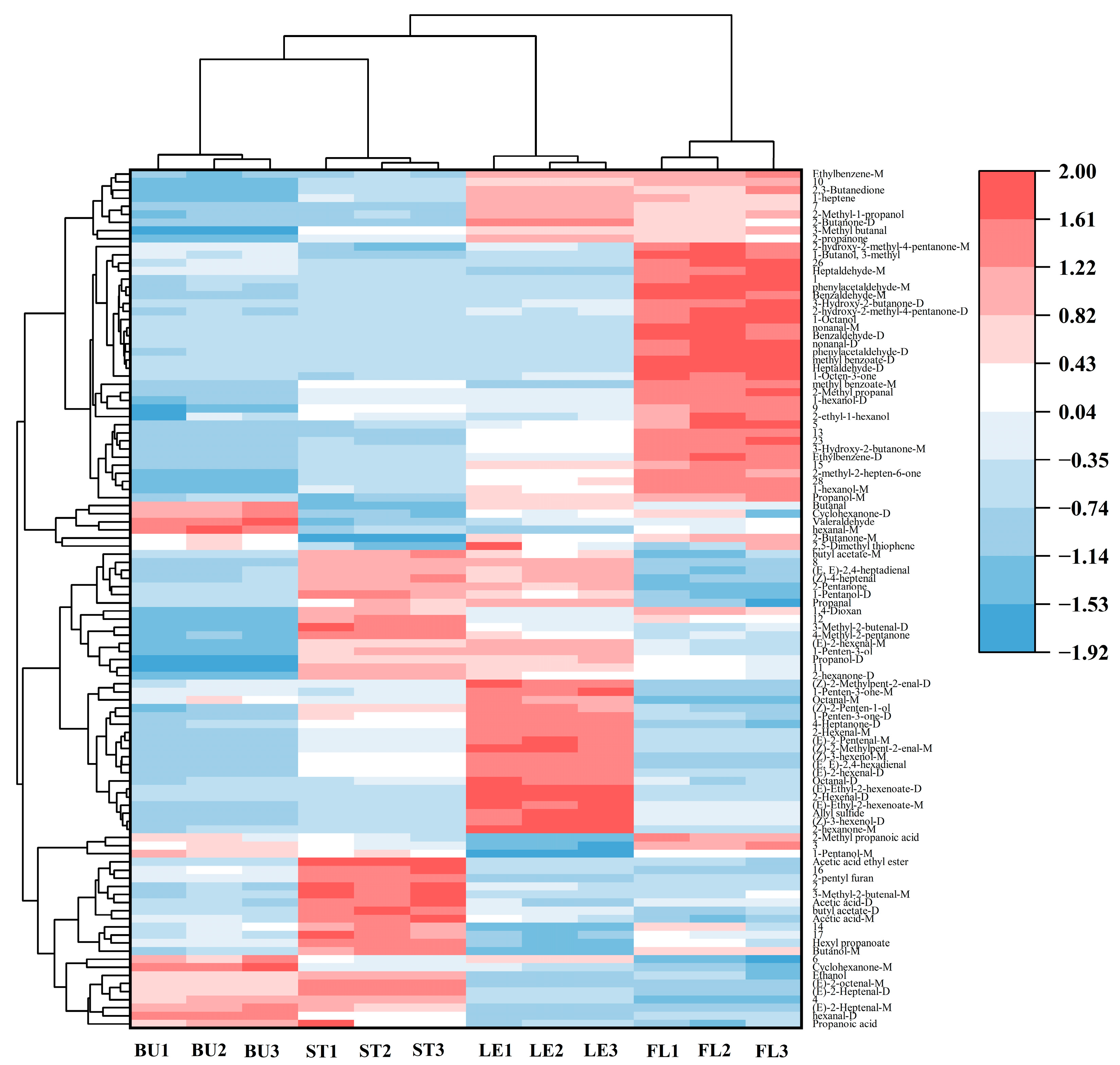
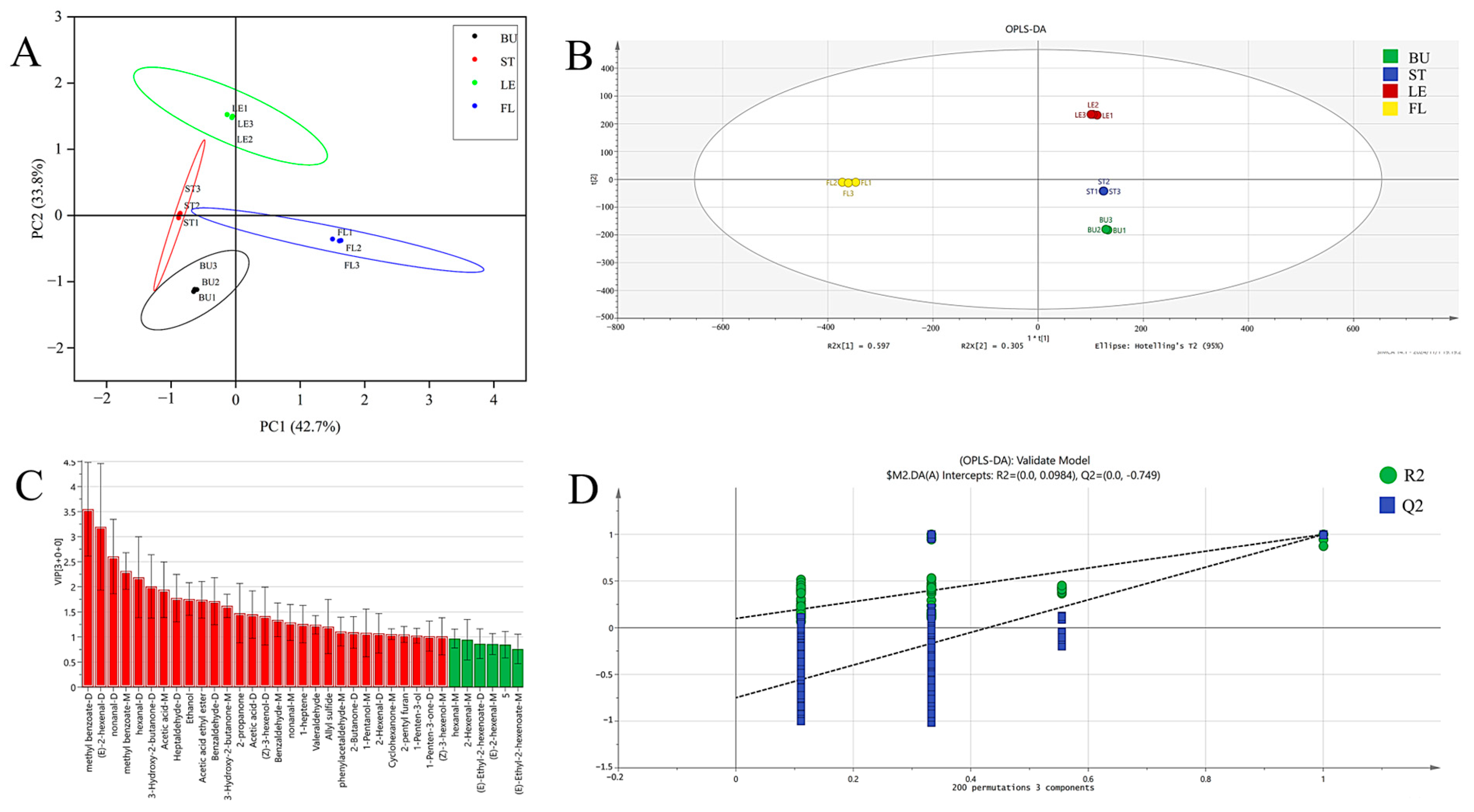
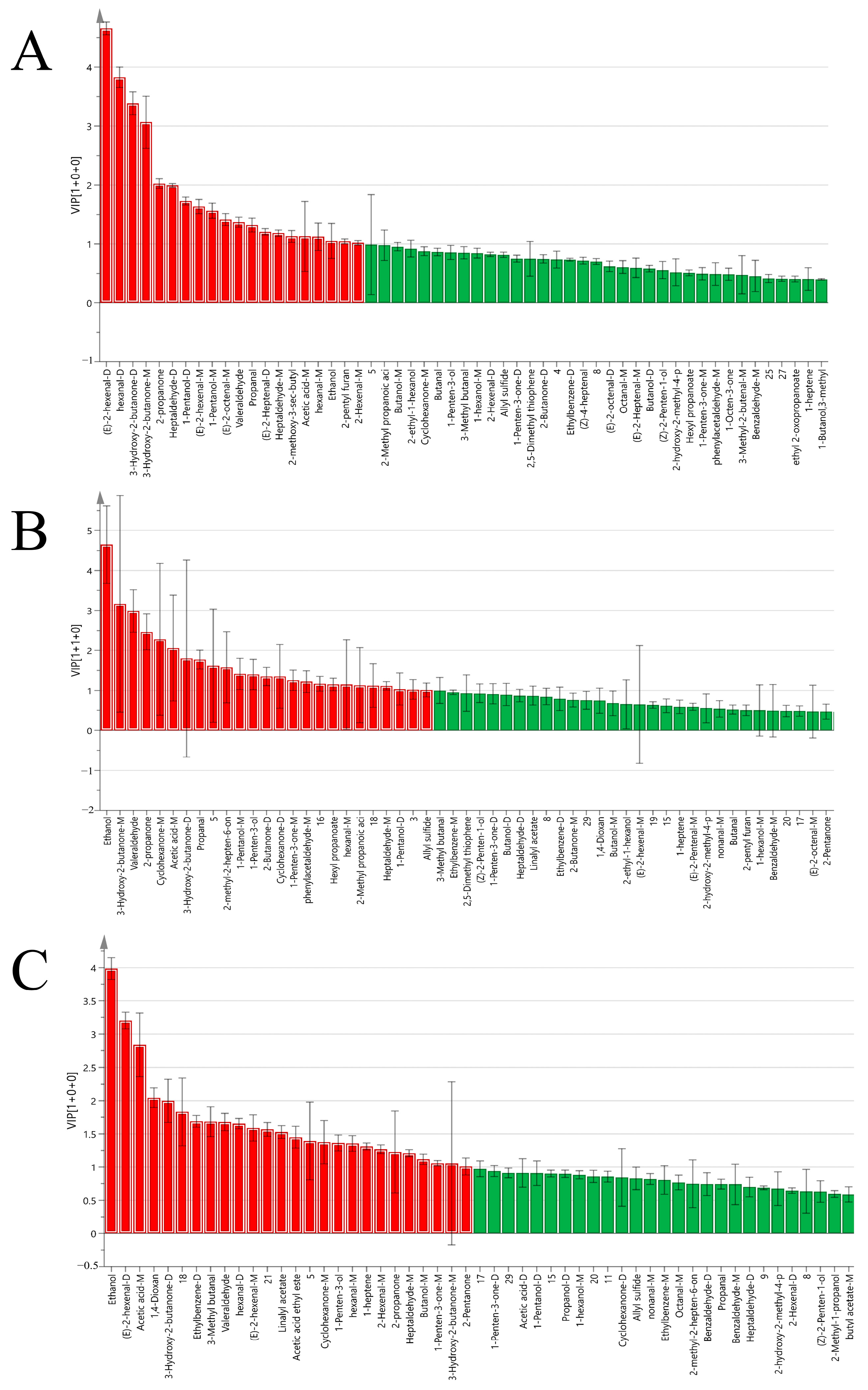
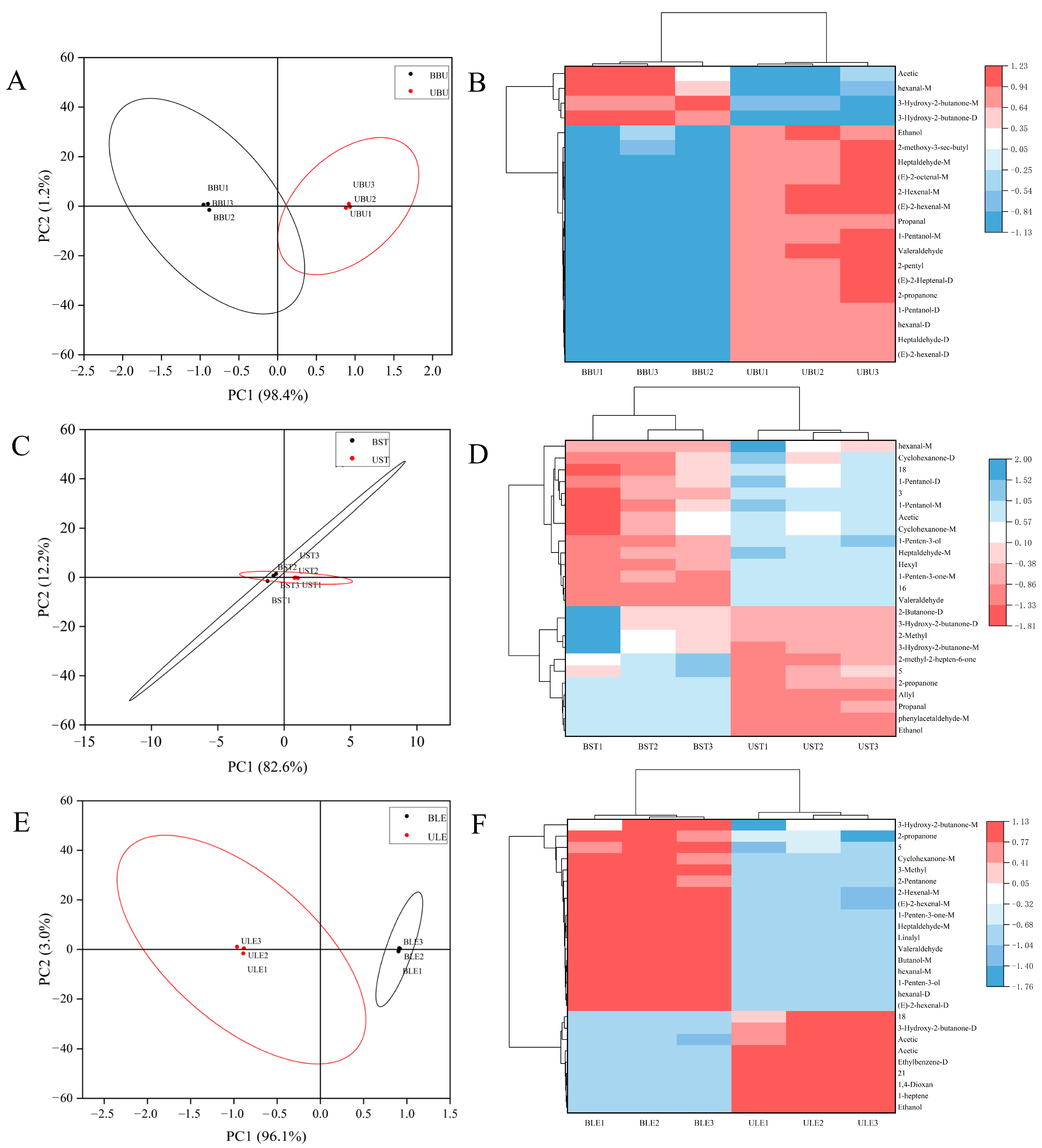

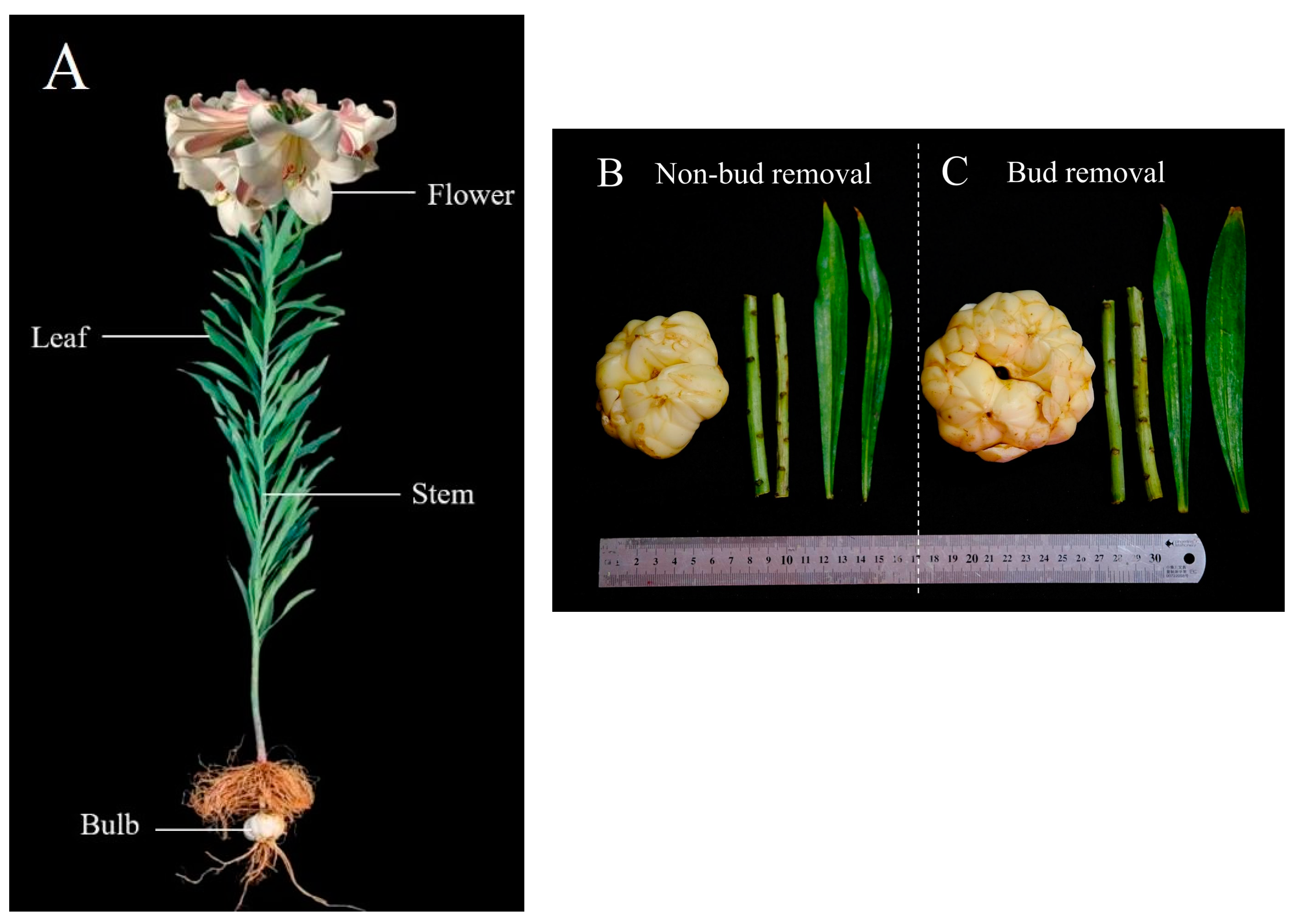
| Count | Compound | CAS# | Formula | MW | RI | Rt [sec] | Dt [a.u.] | Flavor Description |
|---|---|---|---|---|---|---|---|---|
| 1 | 1 | unidentified | * | 0 | 1169.9 | 376.591 | 1.19667 | / |
| 2 | 2 | unidentified | * | 0 | 1460.6 | 862.462 | 1.20404 | / |
| 3 | methyl benzoate-D | C93583 | C8H8O2 | 136.1 | 1583.5 | 1162.145 | 1.59803 | wintergreen, almond, floral, cananga |
| 4 | methyl benzoate-M | C93583 | C8H8O2 | 136.1 | 1583 | 1160.532 | 1.22269 | wintergreen, almond, floral, cananga |
| 5 | Acetic acid-D | C64197 | C2H4O2 | 60.1 | 1466.7 | 875.513 | 1.16392 | spicy |
| 6 | Acetic acid-M | C64197 | C2H4O2 | 60.1 | 1463.9 | 869.582 | 1.05376 | spicy |
| 7 | Benzaldehyde-M | C100527 | C7H6O | 106.1 | 1495.9 | 939.747 | 1.14947 | bitter almond, cherry, nutty |
| 8 | Benzaldehyde-D | C100527 | C7H6O | 106.1 | 1495.9 | 939.747 | 1.46835 | bitter almond, cherry, nutty |
| 9 | 1-Octanol | C111875 | C8H18O | 130.2 | 1554.4 | 1083.003 | 1.47033 | citrus, sweet, herbs, waxy, rose, mushroom |
| 10 | Propanoic acid | C79094 | C3H6O2 | 74.1 | 1543.5 | 1054.513 | 1.10979 | yogurt, vinegar |
| 11 | phenylacetaldehyde-M | C122781 | C8H8O | 120.2 | 1610.2 | 1239.896 | 1.25793 | hyacinth, sweet fruity, almond, cherry, clover honey, cocoa |
| 12 | phenylacetaldehyde-D | C122781 | C8H8O | 120.2 | 1608 | 1233.039 | 1.53866 | hyacinth, sweet fruity, almond, cherry, clover honey, cocoa |
| 13 | (E,E)-2,4-heptadienal | C4313035 | C7H10O | 110.2 | 1477.8 | 899.391 | 1.19427 | fatty, oily, aldehyde, vegetable, cinnamon |
| 14 | (Z)-3-hexenol-D | C928961 | C6H12O | 100.2 | 1397.7 | 740.494 | 1.50195 | green, herb |
| 15 | (Z)-3-hexenol-M | C928961 | C6H12O | 100.2 | 1399.3 | 743.433 | 1.2367 | green, herb |
| 16 | (E)-Ethyl-2-hexenoate-D | C27829727 | C8H14O2 | 142.2 | 1336.6 | 638.609 | 1.80277 | fruity, vegetable |
| 17 | (E)-Ethyl-2-hexenoate-M | C27829727 | C8H14O2 | 142.2 | 1337.1 | 639.327 | 1.33034 | fruity, vegetable |
| 18 | (Z)-2-Penten-1-ol | C1576950 | C5H10O | 86.1 | 1345.6 | 652.643 | 0.94494 | green, plastic, rubber |
| 19 | 1-Penten-3-ol | C616251 | C5H10O | 86.1 | 1175.1 | 383.645 | 0.94119 | ethereal, green, tropical fruity |
| 20 | (E)-2-Heptenal-D | C18829555 | C7H12O | 112.2 | 1340.7 | 644.937 | 1.66537 | spicy, green vegetables, fresh, fatty |
| 21 | nonanal-M | C124196 | C9H18O | 142.2 | 1396.2 | 737.808 | 1.47457 | rose, citrus, strong oily |
| 22 | nonanal-D | C124196 | C9H18O | 142.2 | 1402.1 | 748.498 | 1.9419 | rose, citrus, strong oily |
| 23 | 3 | unidentified | * | 0 | 1425.4 | 791.89 | 1.44527 | / |
| 24 | 4 | unidentified | * | 0 | 1411.7 | 766.005 | 1.26022 | / |
| 25 | 1-hexanol-M | C111273 | C6H14O | 102.2 | 1373.7 | 698.59 | 1.32522 | fresh, fruity, wine, sweet, green |
| 26 | 1-hexanol-D | C111273 | C6H14O | 102.2 | 1373.4 | 698.21 | 1.64602 | fresh, fruity, wine, sweet, green |
| 27 | 5 | unidentified | * | 0 | 1386.2 | 720.223 | 1.10028 | / |
| 28 | 2-methyl-2-hepten-6-one | C110930 | C8H14O | 126.2 | 1354.9 | 667.545 | 1.17293 | citrus, fruity, moldy, ketone |
| 29 | 3-Hydroxy-2-butanone-D | C513860 | C4H8O2 | 88.1 | 1292.8 | 572.967 | 1.32387 | butter, cream |
| 30 | 3-Hydroxy-2-butanone-M | C513860 | C4H8O2 | 88.1 | 1291.9 | 571.182 | 1.06837 | butter, cream |
| 31 | 1-Octen-3-one | C4312996 | C8H14O | 126.2 | 1318.1 | 610.458 | 1.27406 | strong earthy, mushroom, vegetable, fishy, chicken |
| 32 | Cyclohexanone-M | C108941 | C6H10O | 98.1 | 1292.8 | 572.967 | 1.15354 | strong, pungent, earthy |
| 33 | Cyclohexanone-D | C108941 | C6H10O | 98.1 | 1294.6 | 576.538 | 1.45082 | strong, pungent, earthy |
| 34 | 6 | unidentified | * | 0 | 1300.2 | 584.571 | 1.63401 | / |
| 35 | 1-Pentanol-D | C71410 | C5H12O | 88.1 | 1260.8 | 514.052 | 1.51188 | balsamic |
| 36 | 1-Pentanol-M | C71410 | C5H12O | 88.1 | 1261.3 | 514.945 | 1.25317 | balsamic |
| 37 | (E)-2-hexenal-D | C6728263 | C6H10O | 98.1 | 1227.5 | 459.155 | 1.51349 | green, banana, fat |
| 38 | (E)-2-hexenal-M | C6728263 | C6H10O | 98.1 | 1229.3 | 462.074 | 1.17803 | green, banana, fat |
| 39 | 2-pentyl furan | C3777693 | C9H14O | 138.2 | 1239.5 | 478.302 | 1.2495 | bean, fruity, earthy, green, vegetable |
| 40 | Heptaldehyde-D | C111717 | C7H14O | 114.2 | 1195.1 | 411.362 | 1.69333 | fresh, aldehyde, fatty, green herbs, wine, fruity |
| 41 | Heptaldehyde-M | C111717 | C7H14O | 114.2 | 1197 | 414.067 | 1.33789 | resh, aldehyde, fatty, green herbs, wine, fruity |
| 42 | Ethylbenzene-D | C100414 | C8H10 | 106.2 | 1145.6 | 345.742 | 1.44536 | aromatic odor |
| 43 | Ethylbenzene-M | C100414 | C8H10 | 106.2 | 1141.4 | 340.675 | 1.07501 | aromatic odor |
| 44 | Allyl sulfide | C592881 | C6H10S | 114.2 | 1138.3 | 336.989 | 1.33025 | garlic |
| 45 | hexanal-D | C66251 | C6H12O | 100.2 | 1097.7 | 292.071 | 1.54566 | fresh, green, fat, fruity |
| 46 | hexanal-M | C66251 | C6H12O | 100.2 | 1092.6 | 287.381 | 1.27156 | fresh, green, fat, fruity |
| 47 | 1,4-Dioxan | C123911 | C4H8O2 | 88.1 | 1081.9 | 278.003 | 1.13124 | pungent, ether |
| 48 | (Z)-4-heptenal | C6728310 | C7H12O | 112.2 | 1252.8 | 500.362 | 1.1452 | grass, oil |
| 49 | 2-Hexenal-D | C505577 | C6H10O | 98.1 | 1213.3 | 437.675 | 1.50904 | sweet almonds, fruity, green leaves, apples, plums, vegetables |
| 50 | 2-Hexenal-M | C505577 | C6H10O | 98.1 | 1213.7 | 438.253 | 1.18088 | sweet almonds, fruity, green leaves, apples, plums, vegetables |
| 51 | (Z)-2-Methylpent-2-enal-D | C623369 | C6H10O | 98.1 | 1161.8 | 366.033 | 1.48549 | aldehydes, soil, garlic, ripe cherries |
| 52 | (Z)-2-Methylpent-2-enal-M | C623369 | C6H10O | 98.1 | 1161.8 | 366.033 | 1.15671 | aldehydes, soil, garlic, ripe cherries, |
| 53 | 4-Heptanone-D | C123193 | C7H14O | 114.2 | 1170.2 | 377.008 | 1.57425 | fruity |
| 54 | 4-Heptanone-M | C123193 | C7H14O | 114.2 | 1170.2 | 377.008 | 1.22172 | fruity |
| 55 | Butanol-M | C71363 | C4H10O | 74.1 | 1154.7 | 357.01 | 1.17922 | wine |
| 56 | (E)-2-Pentenal-M | C1576870 | C5H8O | 84.1 | 1124.3 | 320.671 | 1.10921 | potato, peas |
| 57 | (E)-2-Pentenal-D | C1576870 | C5H8O | 84.1 | 1122.5 | 318.72 | 1.36298 | potato, peas |
| 58 | 2-hexanone-M | C591786 | C6H12O | 100.2 | 1116.8 | 312.379 | 1.19797 | fruity, fungal, meaty, buttery |
| 59 | 2-hexanone-D | C591786 | C6H12O | 100.2 | 1117 | 312.623 | 1.503 | fruity, fungal, meaty, buttery |
| 60 | 7 | unidentified | * | 0 | 1111.5 | 306.526 | 1.08806 | / |
| 61 | butyl acetate-M | C123864 | C6H12O2 | 116.2 | 1086.4 | 281.893 | 1.2377 | fruity |
| 62 | butyl acetate-D | C123864 | C6H12O2 | 116.2 | 1084.5 | 280.186 | 1.61745 | fruity |
| 63 | 2,5-Dimethyl thiophene | C638028 | C6H8S | 112.2 | 1187.1 | 400.177 | 1.07926 | nutty, sulfury |
| 64 | 8 | unidentified | * | 0 | 1061.4 | 260.8 | 1.19748 | / |
| 65 | Propanol-M | C71238 | C3H8O | 60.1 | 1049.9 | 251.667 | 1.11275 | alcohol, pungent |
| 66 | Propanol-D | C71238 | C3H8O | 60.1 | 1049.2 | 251.141 | 1.25578 | alcohol, pungent |
| 67 | 1-Penten-3-one-D | C1629589 | C5H8O | 84.1 | 1038.8 | 243.136 | 1.3087 | strong, pungent odors |
| 68 | 1-Penten-3-one-M | C1629589 | C5H8O | 84.1 | 1040.6 | 244.541 | 1.0782 | strong, pungent odors |
| 69 | Ethanol | C64175 | C2H6O | 46.1 | 937.8 | 182.624 | 1.11856 | aromaticity |
| 70 | 3-Methyl butanal | C590863 | C5H10O | 86.1 | 931.5 | 179.591 | 1.39948 | chocolate, fat |
| 71 | 2-Pentanone | C107879 | C5H10O | 86.1 | 1020.5 | 229.743 | 1.38929 | acetone, fresh, sweet fruity, wine |
| 72 | 2,3-Butanedione | C431038 | C4H6O2 | 86.1 | 991.4 | 210.382 | 1.17293 | butter, popcorn, sweet taste, sour rice |
| 73 | Valeraldehyde | C110623 | C5H10O | 86.1 | 1000.6 | 215.981 | 1.41874 | green grassy, faint banana, pungent |
| 74 | 9 | unidentified | * | 0 | 1050.8 | 252.37 | 0.94639 | / |
| 75 | 10 | unidentified | * | 0 | 1012.2 | 223.912 | 1.08232 | / |
| 76 | Propanal | C123386 | C3H6O | 58.1 | 815.5 | 132.229 | 1.13813 | pungent, green grassy |
| 77 | 2-propanone | C67641 | C3H6O | 58.1 | 837.9 | 140.273 | 1.11396 | fresh, apple, pear |
| 78 | 11 | unidentified | * | 0 | 763.6 | 115.309 | 1.13289 | / |
| 79 | 12 | unidentified | * | 0 | 712.2 | 100.659 | 1.14176 | / |
| 80 | 1-heptene | C592767 | C7H14 | 98.2 | 786.5 | 122.467 | 1.08648 | gasoline |
| 81 | 13 | unidentified | * | 0 | 792.8 | 124.54 | 1.1205 | / |
| 82 | 2-Methyl propanal | C78842 | C4H8O | 72.1 | 830.7 | 137.617 | 1.27928 | banana, melon, slightly nutty |
| 83 | 14 | unidentified | * | 0 | 853.6 | 146.206 | 1.15295 | / |
| 84 | Butanal | C123728 | C4H8O | 72.1 | 893.8 | 162.566 | 1.27842 | pungent, fruity, green leaf |
| 85 | Acetic acid ethyl ester | C141786 | C4H8O2 | 88.1 | 900.1 | 165.289 | 1.33457 | fresh, fruity, sweet, grassy |
| 86 | 15 | unidentified | * | 0 | 798 | 126.256 | 0.96012 | / |
| 87 | 2-Butanone-D | C78933 | C4H8O | 72.1 | 917.5 | 173.073 | 1.24453 | fruity, camphor |
| 88 | 2-Butanone-M | C78933 | C4H8O | 72.1 | 916.7 | 172.686 | 1.0679 | fruity, camphor |
| 89 | 16 | unidentified | * | 0 | 868.1 | 151.895 | 1.05772 | / |
| 90 | 3-Methyl-2-butenal-M | C107868 | C5H8O | 84.1 | 1212 | 435.627 | 1.09106 | fruity |
| 91 | 3-Methyl-2-butenal-D | C107868 | C5H8O | 84.1 | 1210.7 | 433.784 | 1.35477 | fruity |
| 92 | 4-Methyl-2-pentanone | C108101 | C6H12O | 100.2 | 1023.5 | 231.888 | 1.47906 | ketone |
| 93 | 2-hydroxy-2-methyl-4-pentanone-M | C123422 | C6H12O2 | 116.2 | 1372.5 | 696.599 | 1.13723 | mild, pleasant |
| 94 | 2-hydroxy-2-methyl-4-pentanone-D | C123422 | C6H12O2 | 116.2 | 1372.4 | 696.508 | 1.52947 | mild, pleasant |
| 95 | Hexyl propanoate | C2445763 | C9H18O2 | 158.2 | 1349.2 | 658.425 | 1.42698 | sweet fruity, earthy, pungent aroma resembling rotten fruits |
| 96 | ethyl 2-oxopropanoate | C617356 | C5H8O3 | 116.1 | 1277.1 | 543.21 | 1.15559 | fruity, sweet rum, vegetable caramel |
| 97 | Octanal-M | C124130 | C8H16O | 128.2 | 1303.7 | 589.545 | 1.41017 | aldehyde, waxy, citrus, orange, fruity |
| 98 | Octanal-D | C124130 | C8H16O | 128.2 | 1303.4 | 589.119 | 1.81914 | aldehyde, waxy, citrus, orange, fruity |
| 99 | 17 | unidentified | * | 0 | 1195.6 | 412.137 | 1.43025 | / |
| 100 | 18 | unidentified | * | 0 | 1320.8 | 614.48 | 1.15761 | / |
| 101 | 19 | unidentified | * | 0 | 996.8 | 213.472 | 1.10373 | / |
| 102 | 20 | unidentified | * | 0 | 1112.5 | 307.631 | 1.34941 | / |
| 103 | 21 | unidentified | * | 0 | 1098.2 | 292.531 | 1.36487 | / |
| 104 | 22 | unidentified | * | 0 | 997.2 | 213.687 | 1.46595 | / |
| 105 | 2-Methyl-1-propanol | C78831 | C4H10O | 74.1 | 1104.5 | 299.062 | 1.17395 | fresh, alcoholic, leather |
| 106 | 23 | unidentified | * | 0 | 1107.3 | 302.095 | 1.10657 | / |
| 107 | 24 | unidentified | * | 0 | 1067 | 265.431 | 1.80481 | / |
| 108 | (E)-2-octenal-D | C2548870 | C8H14O | 126.2 | 1427.1 | 795.165 | 1.81291 | fresh cucumber, fatty, green herbal, banana, green leaf |
| 109 | (E)-2-octenal-M | C2548870 | C8H14O | 126.2 | 1426.7 | 794.437 | 1.33114 | fresh cucumber, fatty, green herbal, banana, green leaf |
| 110 | 25 | unidentified | * | 0 | 1410.5 | 763.929 | 1.77584 | / |
| 111 | 26 | unidentified | * | 0 | 1357.7 | 671.983 | 1.10533 | / |
| 2-methoxy-3-sec-butyl | moldy, green, vegetable, nutty, | |||||||
| 112 | pyrazine | C24168705 | C9H14N2O | 166.2 | 1509.3 | 970.767 | 1.26067 | pepper, potato, fishy, galbanum |
| 113 | 2-ethyl-1-hexanol | C104767 | C8H18O | 130.2 | 1513.4 | 980.45 | 1.40846 | citrus, fresh floral, greasy |
| 114 | 27 | unidentified | * | 0 | 1436.3 | 813.124 | 1.1974 | / |
| 115 | 2-Methyl propanoic acid | C79312 | C4H8O2 | 88.1 | 1576.7 | 1143.045 | 1.15493 | yogurt, rancid cream |
| 116 | (E,E)-2,4-hexadienal | C142836 | C6H8O | 96.1 | 1408.6 | 760.381 | 1.1187 | sweet, green, floral, citrus |
| 117 | 28 | unidentified | * | 0 | 1252.9 | 500.488 | 1.20531 | / |
| 118 | (E)-2-Heptenal-M | C18829555 | C7H12O | 112.2 | 1340.8 | 645.07 | 1.25453 | spicy, green vegetables, fresh, fatty |
| 119 | Butanol-D | C71363 | C4H10O | 74.1 | 1153.9 | 356.001 | 1.38279 | wine |
| 120 | 29 | unidentified | * | 0 | 1146.7 | 347.035 | 1.11051 | / |
| 121 | 1-Butanol, 3-methyl | C123513 | C5H12O | 88.1 | 1217.5 | 443.959 | 1.24245 | whiskey, banana, fruity |
| 122 | 30 | unidentified | * | 0 | 897.1 | 164.007 | 1.0438 | / |
| 123 | 31 | unidentified | * | 0 | 1083.1 | 279 | 1.51066 | / |
| 124 | Linalyl acetate | C115957 | C12H20O2 | 196.3 | 1547.5 | 1064.871 | 1.21531 | lily of the valley, lavender |
| Sample | Aldehydes | Alcohols | Acids | Ketones | Hydrocarbon | Esters | Heterocycle | Unknown |
|---|---|---|---|---|---|---|---|---|
| BU | 45.58 ± 0.30 d | 18.26 ± 0.30 d | 10.84 ± 0.91 c | 16.33 ± 0.25 b | 1.56 ± 0.05 a | 3.76 ± 0.23 a | 0.86 ± 0.03 b | 2.80 ± 0.14 a |
| ST | 38.09 ± 0.10 a | 17.12 ± 0.05 c | 12.16 ± 0.26 c | 14.85 ± 0.08 a | 2.83 ± 0.07 b | 9.98 ± 0.11 c | 1.47 ± 0.05 c | 3.50 ± 0.03 b |
| LE | 42.29 ± 0.12 c | 14.50 ± 0.12 b | 7.10 ± 0.78 b | 21.86 ± 0.52 d | 6.33 ± 0.07 d | 4.18 ± 0.11 b | 0.34 ± 0.03 a | 3.40 ± 0.12 b |
| FL | 39.28 ± 0.19 b | 8.74 ± 0.62 a | 4.35 ± 0.32 a | 18.01 ± 0.19 c | 3.35 ± 0.03 c | 22.53 ± 0.12 d | 0.38 ± 0.01 a | 3.35 ± 0.16 b |
| BBU | 30.68 ± 0.27 a | 18.98 ± 0.12 c | 8.88 ± 0.52 c | 35.16 ± 0.33 e | 0.62 ± 0.03 a | 0.76 ± 0.04 a | 1.02 ± 0.19 b | 3.90 ± 0.19 a |
| BST | 54.51 ± 0.49 d | 17.87 ± 0.14 b | 4.40 ± 0.31 a | 14.92 ± 0.55 a | 1.25 ± 0.04 b | 0.81 ± 0.06 a | 1.83 ± 0.07 c | 4.42 ± 0.45 a |
| BLE | 30.13 ± 0.32 a | 21.92 ± 0.34 e | 7.20 ± 0.27 b | 28.96 ± 0.92 d | 1.91 ± 0.04 d | 1.73 ± 0.02 b | 0.96 ± 0.08 b | 7.19 ± 0.50 b |
| UBU | 33.45 ± 0.81 b | 20.20 ± 0.21 d | 6.55 ± 0.60 b | 28.01 ± 0.16 d | 1.49 ± 0.03 c | 2.02 ± 0.01 c | 0.80 ± 0.02 b | 7.48 ± 0.20 b |
| UST | 40.84 ± 0.26 c | 13.09 ± 0.18 a | 3.66 ± 0.33 a | 25.89 ± 0.26 c | 6.38 ± 0.13 e | 2.55 ± 0.02 e | 0.49 ± 0.08 a | 7.10 ± 0.15 b |
| ULE | 29.86 ± 0.59 a | 18.04 ± 0.31 b | 7.16 ± 0.35 b | 24.23 ± 0.48 b | 8.04 ± 0.11 f | 2.22 ± 0.12 d | 2.01 ± 0.08 c | 8.44 ± 0.35 c |
Disclaimer/Publisher’s Note: The statements, opinions and data contained in all publications are solely those of the individual author(s) and contributor(s) and not of MDPI and/or the editor(s). MDPI and/or the editor(s) disclaim responsibility for any injury to people or property resulting from any ideas, methods, instructions or products referred to in the content. |
© 2025 by the authors. Licensee MDPI, Basel, Switzerland. This article is an open access article distributed under the terms and conditions of the Creative Commons Attribution (CC BY) license (https://creativecommons.org/licenses/by/4.0/).
Share and Cite
Li, X.; Wang, Z.; Hou, C.; Gong, X.; Liu, Z.; Shi, Y.; Yan, J.; Tong, Q. Identification and Characterization of Volatile Organic Compounds Based on GC-IMS Technology in Different Organs of Lilium brownii var. viridulum and After Bud-Removal and Non-Bud-Removal Treatments. Molecules 2025, 30, 1238. https://doi.org/10.3390/molecules30061238
Li X, Wang Z, Hou C, Gong X, Liu Z, Shi Y, Yan J, Tong Q. Identification and Characterization of Volatile Organic Compounds Based on GC-IMS Technology in Different Organs of Lilium brownii var. viridulum and After Bud-Removal and Non-Bud-Removal Treatments. Molecules. 2025; 30(6):1238. https://doi.org/10.3390/molecules30061238
Chicago/Turabian StyleLi, Xiaoling, Zhihui Wang, Chaowen Hou, Xiujuan Gong, Zexiang Liu, Yuhe Shi, Jianye Yan, and Qiaozhen Tong. 2025. "Identification and Characterization of Volatile Organic Compounds Based on GC-IMS Technology in Different Organs of Lilium brownii var. viridulum and After Bud-Removal and Non-Bud-Removal Treatments" Molecules 30, no. 6: 1238. https://doi.org/10.3390/molecules30061238
APA StyleLi, X., Wang, Z., Hou, C., Gong, X., Liu, Z., Shi, Y., Yan, J., & Tong, Q. (2025). Identification and Characterization of Volatile Organic Compounds Based on GC-IMS Technology in Different Organs of Lilium brownii var. viridulum and After Bud-Removal and Non-Bud-Removal Treatments. Molecules, 30(6), 1238. https://doi.org/10.3390/molecules30061238






